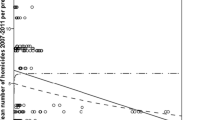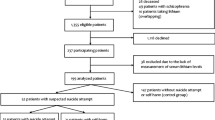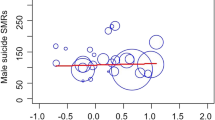Abstract
The purpose of the present study was to evaluate the association between lithium levels in the public water supply and prefecture-based suicide rates in Greece. Analyses were conducted with respect to lithium levels in 149 samples from 34 prefectures of Greece. The average lithium level was 11.10 μg/l (range 0.1 to 121 μg/l). The results indicate that there is a tendency for lower suicide rates in the prefectures with high levels of lithium in drinking water. Ecological studies explained by researchers Schrauzer and Shrestha have revealed the existence of statistically significant inverse associations between the lithium levels in drinking water and the incidence of suicides, homicides, rapes, possession of narcotic drugs, and in juveniles, the rates of runaway from home. Such a result of inverse relationship was not proven by Kabacs et al., most likely because the differences of the lithium levels in the selection of their case–control samples were not large enough. In addition, probably the selection of random regions in Japan and East England might have been biased. Thus, the addition of small amounts of lithium to the drinking water could provide an effective means to lower the incidence of these conditions in the general population. Furthermore, the nutritional importance of lithium in the form of the carbonate named lithium carbonate (Li2CO3) is currently still viewed primarily as a pharmacological agent. The study by Al-Chalabi et al. state that the therapeutic activity of lithium in amyotrophic lateral sclerosis (ALS) is worth investigating. Any drug that can be shown to slow the course of ALS in a clinically significant way and to be safe and well tolerated will be an important advance for patients with this disease.

Similar content being viewed by others
References
Schrauzer GN (2002) Lithium: occurrence, dietary intakes, nutritional essentiality. J Am Coll Nutr 21(1):14–21
Schrauzer GN, Shrestha KP (1990) Lithium in drinking water and the incidences of crimes, suicides, and arrests related to drug addictions. Biol Trace Elem Res 25(2):105
Ohgami H et al (2009) Lithium levels in drinking water and risk of suicide. Br J Psychiatry 194(5):464–465
Kapusta ND et al (2011) Lithium in drinking water and suicide mortality. Br J Psychiatry 198(5):346–350
Bluml V, Regier MD, Hlavin G, Rockett IR, Konig F, Vyssoki B, Bschor T, Kapusta ND (2013) Lithium in the public water supply and suicide mortality in Texas. J Psychiatr Res 47(3):407–411
Kabacs N et al (2011) Lithium in drinking water and suicide rates across the East of England. Br J Psychiatry 198(5):406–407
Schrauzer G et al (1992) Lithium in scalp hair of adults students and violent criminals. Biol Trace Elem Res 34:161–176
Zarse K, Terao T, Tian J, Iwata N, Ishii N, Ristow M (2011) Low-dose lithium uptake promotes longevity in humans and metazoans. Eur J Nutr 50(5):387–389
Broberg K, Concha G, Engstrom K, Lindvall M, Grander M, Vahter M (2011) Lithium in drinking water and thyroid function. Environ Health Perspect 119(6):827–830
Hu Wen L et al (2011) The role of Wnt signaling and its interaction with diverse mechanisms of cellular apoptosis in the pathophysiology of bipolar disorder. Prog neuro-psychopharmacol biol psychiatry 35:11–17
Rapoport SI, Basselin M, Kim HW, Rao JS (2009) Bipolar disorder and mechanisms of action of mood stabilizers. Brain Res Rev 61(2):185–209
Mankul E, Dalwani M, Nicoletti M et al (2004) Brain gray matter changes after lithium treatment : a voxel-based morphometry study in healthy individuals. Biol Psychiatry 8(suppl 1):202 S
Al-Chalabi A, Shaw PJ et al (2011) Protocol for a double-blind randomised placebo controlled trial of lithium carbonate in patients with amyotrophic lateral sclerosis (LiCALS). BMC Neurol 11:111
Helbich et al (2012) Geospatial examination of lithium in drinking water and suicide mortality. In J Health Geogr 11(19):1–8
Stefansson A, Gunnarsson I, Giroud N (2007) New methods for the direct determination of dissolved inorganic, organic and total carbon in natural waters by reagent-free ion chromatography and inductively coupled plasma atomic emission spectrometry. Anal Chim Acta 582:69–74
Helbich M, Bluml V, Leitner M, Kapusta ND (2013) Does altitude moderate the impact of lithium on suicide. A Spat Anal Austria Geospat Health 7(2):209–218
Rasmus et al (2012) Lithium: still a major option in the management of bipolar disorder. CNS Neurosci Ther 18(3):219–226
Acknowledgments
The authors would like to acknowledge the following:  SPECIFAR – ACTAVIS PHARMACEUTICALS for the collection of water samples; Center of Biological Research of Armed Forces, 414 Hospital of Athens for the analysis of water samples; National Statistic Service of Greece (Hellenic Statistical Authority - EL.STAT) for its contribution in providing data base regarding suicide rates; Tsouvelas George who is supported by a grant from “Alexander S. Onassis” Public Benefit Foundation for doctoral studies; Nissiannakis Paul, Chemist, MSc, Center of Biological Research of Armed Forces, 414 Military Hospital of Athens; Giakalou Vera-Varvara, Molecular Neuroscientist as a corresponding author for bibliography research (Medline, PubMed literature search) regarding the investigation role of lithium and her contribution of rewriting the manuscript according to Editor’s guidance and instructions of BTER for submission; Lavdas Alexandros, PhD, Bio-optics Senior Researcher at EURAC Research, Italy for his guidance in providing material in lithium study. Prof. Giotakos Orestis and the corresponding author of this work, Giakalou Vera-Varvara, thank in advance the Editor in Chief, Dr. Gerhard Schrauzer, and the Associate Editor and the Managing Editor, Dr. Manuel Flores – Arce for guidance of the manuscript submission to the Journal Biological Trace Elements Research.
SPECIFAR – ACTAVIS PHARMACEUTICALS for the collection of water samples; Center of Biological Research of Armed Forces, 414 Hospital of Athens for the analysis of water samples; National Statistic Service of Greece (Hellenic Statistical Authority - EL.STAT) for its contribution in providing data base regarding suicide rates; Tsouvelas George who is supported by a grant from “Alexander S. Onassis” Public Benefit Foundation for doctoral studies; Nissiannakis Paul, Chemist, MSc, Center of Biological Research of Armed Forces, 414 Military Hospital of Athens; Giakalou Vera-Varvara, Molecular Neuroscientist as a corresponding author for bibliography research (Medline, PubMed literature search) regarding the investigation role of lithium and her contribution of rewriting the manuscript according to Editor’s guidance and instructions of BTER for submission; Lavdas Alexandros, PhD, Bio-optics Senior Researcher at EURAC Research, Italy for his guidance in providing material in lithium study. Prof. Giotakos Orestis and the corresponding author of this work, Giakalou Vera-Varvara, thank in advance the Editor in Chief, Dr. Gerhard Schrauzer, and the Associate Editor and the Managing Editor, Dr. Manuel Flores – Arce for guidance of the manuscript submission to the Journal Biological Trace Elements Research.
This study was not funded by Actavis–Specifar Pharmaceuticals  as its contribution is based on: collection of sample waters in Greece (by Central Nervous System Unit-Team) and guidance of corresponding author Vera-Varvara Giakalou, Molecular Neuroscientist, MSc regarding analysis and investigation of the role of lithium.
as its contribution is based on: collection of sample waters in Greece (by Central Nervous System Unit-Team) and guidance of corresponding author Vera-Varvara Giakalou, Molecular Neuroscientist, MSc regarding analysis and investigation of the role of lithium.
Conflict of Interest
The authors do not have financial or nonfinancial competing interests by publishing this article.
Author information
Authors and Affiliations
Corresponding author
Rights and permissions
About this article
Cite this article
Giotakos, O., Nisianakis, P., Tsouvelas, G. et al. Lithium in the Public Water Supply and Suicide Mortality in Greece. Biol Trace Elem Res 156, 376–379 (2013). https://doi.org/10.1007/s12011-013-9815-4
Received:
Accepted:
Published:
Issue Date:
DOI: https://doi.org/10.1007/s12011-013-9815-4




